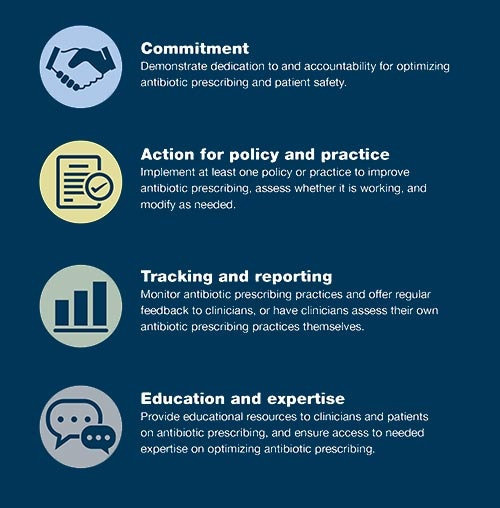
5 Things to Improve Antibiotic Use in Outpatient Telemedicine
Most human antibiotic use occurs in outpatient settings, and at least 28% of antibiotic use in US physician offices and emergency departments is unnecessary and contributes to the development of antimicrobial resistance, excess healthcare costs, and adverse drug events.[1,2] Commercial companies and health systems have expanded outpatient healthcare using telemedicine, including for conditions for which antibiotics are frequently prescribed. CDC's Core Elements of Outpatient Antibiotic Stewardship principles and practices (see Figure below) can be adapted to optimize antibiotic prescribing in outpatient telemedicine.

Here are five things to know about improving antibiotic use in outpatient telemedicine settings.
1. Antibiotics are too often prescribed for respiratory conditions during telemedicine visits.
Whether during virtual or in-person visits, the most common conditions for which antibiotics are prescribed are acute respiratory infections.[3,4] These include sinusitis, pharyngitis, acute bronchitis, acute otitis media, and viral upper respiratory infections. In both virtual and in-person outpatient visits, antibiotic prescribing for these conditions has been observed to be relatively similar and in excess of what is desired and recommended. This is concerning because outpatient antibiotic prescribing in the United States frequently provides minimal benefit — with up to 28% of antibiotic prescribing providing no benefit at all[1] — and antibiotics are among the most common causes of emergency department visits for adverse drug events.[5] Optimizing antibiotic prescribing for acute respiratory conditions is a priority for stewardship interventions in outpatient telemedicine and can be tracked using similar quality metrics as those which are used for in-person settings.[6]
2. Outpatient antibiotic stewardship strategies appear to be effective for virtual visits.
Telemedicine-focused antibiotic stewardship studies have demonstrated that strategies used for in-person settings can be adapted to telemedicine settings. For example, use of public commitment posters, clinical decision support systems (CDSS), and communications skills training have all been adapted to improve antibiotic use in outpatient telemedicine.[7,8,9,10] The adaptation of such strategies can include displaying a public commitment to stewardship in virtual waiting rooms, adapting CDSS to telemedicine workflows, or promoting communication skills training to providers.
3. Standards should be established for telediagnosis and antibiotic prescribing for virtual visits.
Although many conditions are routinely evaluated during virtual visits, sometimes it still may be necessary to perform an in-person physical examination or diagnostic testing to appropriately establish a diagnosis. As such, facility, organization, or health system–specific guidance should be provided to clinicians on the use of telemedicine to establish a diagnosis for specific conditions, and under which circumstances patients should be referred for diagnostic testing and in-person evaluation. Similarly, clearly established standards for antibiotic prescribing in outpatient telemedicine can help inform clinicians how best to manage antibiotic treatment for common infections. For example, local or health system–specific guidelines can be adapted from national clinical practice guidelines for common conditions and shared with clinicians. Read more about adult and pediatric treatment recommendation guidelines on the CDC website.
4. It is important to identify populations at risk of being underserved or excluded by antibiotic stewardship efforts.
Some populations may be inadvertently or systematically disadvantaged by efforts to improve antibiotic use in virtual settings. Approaches to minimize this effect may include equitable promotion of telemedicine services and digital health advocacy efforts, health equity training for clinicians, and consideration of health equity impact during telemedicine workflows.
5. Triage systems can redirect conditions requiring additional support.
Patients should be referred to an alternative healthcare site if a virtual encounter or the virtual care platform is unable to meet the needs of a patient encounter and access to partner services is not available. Reducing unnecessary outpatient visits is a similar strategy that has been employed for in-person settings.[11] Some telemedicine programs have further reduced barriers to appropriate prescribing by taking actions such as waiving or minimizing fees for visits requiring a higher level of care.
Article from Medspace.
------------------------------------------------------------------------------------------------
In this ever-changing landscape, nurses need working knowledge of the antimicrobial agents available, and competency to infuse these medications in all the various administration systems in use today. Our IV Antibiotic Education Package contains the 5 courses below:
- Intravenous Antibiotics: Where We Are and Where We're Going: Additional Classifications
- Intravenous Antibiotics: Where We Are and Where We're Going: Antifungals
- Intravenous Antibiotics: Where We Are and Where We're Going: Antivirals
- Intravenous Antibiotics: Where We Are and Where We're Going: ß-lactams
- Intravenous Antibiotics: Where We Are and Where We're Going: Glycopeptides
Pedagogy's courses are available for purchase by the individual or facility. For individuals, register with us to create your username and password, click on the course title of interest and then click the Buy Now button. For a complete listing of all our online continuing education courses, including the largest selection of infusion continuing education courses offered online, click here!
For organizations that would like to purchase education for their entire staff, email sales@pedagogyeducation.com and let us know the course(s) of interest and how many staff members you need to provide education for, and we will be happy to send you a price quote.

